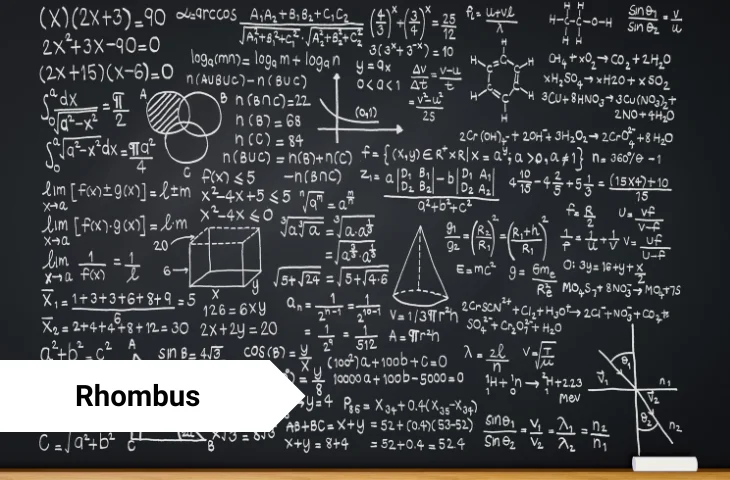In Quantitative Aptitude, the Rhombus is a special type of parallelogram that appears frequently in SSC, Banking, and Railway exams. It tests a candidate’s understanding of geometry properties, diagonal-based formulas, and mensuration skills. In this blog, we have provided all the details including, formulas, types, tricks, solved examples, and more.
What Is Rhombus in Quantitative Aptitude?
A Rhombus is a quadrilateral in which all four sides are equal and opposite sides are parallel. Its diagonals bisect each other at right angles and also bisect the interior angles.
Why it appears in exams:
- Combines properties of square and parallelogram.
- Allows testing of both side-based and diagonal-based area formulas.
Skills required:
- Shape visualization
- Application of diagonal properties
- Formula recall for area & perimeter
Why Is Rhombus Important in Competitive Exams?
Rhombus questions are straightforward once you memorize the formulas, making them a scoring area in exams.
| Exam | No. of Questions | Difficulty |
| SSC CGL / CHSL | 1–2 | Easy |
| IBPS PO / SBI PO | 1–2 | Moderate |
| RRB NTPC / Group D | 1 | Easy |
| State PSC / Police | 1–2 | Moderate |
Rhombus Quantitative Aptitude Short Notes
Short notes based on the topic of rhombus are as follows:
| Term | Details |
| Sides | All sides equal |
| Opposite sides | Parallel |
| Opposite angles | Equal |
| Adjacent angles | Supplementary |
| Diagonals | Bisect each other at 90° |
| Area | ½ × d₁ × d₂ |
| Perimeter | 4 × side |
What Are the Types of Rhombus Questions in Quantitative Aptitude?
Types of questions asked from the topic of rhombus are as follows:
- Direct formula-based: Find area from diagonals.
- Side-based problems: Find perimeter using given side length.
- Diagonal-length problems: Using Pythagoras theorem in halves of diagonals.
- Mixed problems: Combined with trigonometry or coordinate geometry.
Rhombus Formulas for Quantitative Aptitude
Important formulas to solve questions based on rhombus are as follows:

Rhombus Tricks for SSC CGL and Other Exams
Tricks to solve questions based on rhombus are as follows:
- Always check if diagonals are given it’s the quickest way to find area.
- Remember: A square is a rhombus with 90° angles.
- Use Pythagoras theorem on half-diagonals to find side length.
- If perimeter is given, side length = perimeter ÷ 4.
- For coordinate geometry, use distance formula for diagonals, then apply area formula.
Solved Rhombus Questions from 2024–25 Exams

Common Mistakes to Avoid while Solving Rhombus Questions
Common mistakes to avoid while solving questions based on the topic rhombus are as follows:
- Assuming diagonals are equal.
- Forgetting to halve diagonals before using Pythagoras.
- Confusing rhombus with square in angle-related problems.
- Using slant length instead of height in area calculations.
- Ignoring that perimeter requires side length, not diagonal length.
FAQs
A quadrilateral with all sides equal and opposite sides parallel.
No, but they are perpendicular.
Yes, with all angles 90°.
They bisect each other at right angles.
Yes, in Geometry & Mensuration sections.
- MP Apex Bank Vacancy, 2076 Clerk and Officer Posts for 2026 Cycle
- MP Cooperative Bank Recruitment 2026, Apply for 2076 Posts
- MP Apex Bank Syllabus 2026 and Exam Pattern for Clerk and Officer Posts
- SSC CGL Typing Test Error 2025, Full Mistake, Half Mistake
- SSC GD Post Code, Meaning, List, and Selection Process Explained
- SSC GD Total Form Fill Up 2026, Applications, Trend & Competition Ratio

Hi, I’m Aditi. I work as a Content Writer at Oliveboard, where I have been simplifying exam-related content for the past 4 years. I create clear and easy-to-understand guides for JAIIB, CAIIB, and UGC exams. My work includes breaking down notifications, admit cards, and exam updates, as well as preparing study plans and subject-wise strategies.
My goal is to support working professionals in managing their exam preparation alongside a full-time job and to help them achieve career growth.
